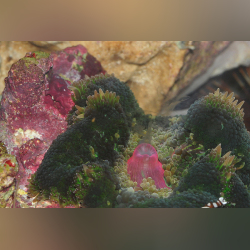Info
Ophiomastix annulosa (Lamarck, 1816)
A large proportion of the brittle stars of the genus Ophiomastix are characterized by certain structures between the spines on their arms that have been converted into “clubs”, the use of which is still poorly understood. Their often very aesthetic appearance and excellent resilience also make them interesting for aquariums.
Since 2019, this genus has included the old genus Ophiarthrum as well as several species previously classified under Ophiocoma (these have no club spines, but the same lecithrophic larva and a great genetic affinity).
The brittle star Ophiomastix annulosa lives benthically, close to shore and is reef associated. It can be found under coral plates, in holes and crevices down to a depth of 11m.
The disk is 2.4 cm in size, the arms up to 20 cm long. In English, the brittle star is known as the “chain-link brittle star”, which translates as “chain-link brittle star” and refers to the structure of its arms.
This brittle star is characterized by a central, round, reddish-brown base color and a pattern of fine white lines that form “diamonds”. It has 5 long arms with black spines and paddle/club shaped structures in between.
Ophiomastix annulosa is said to have a poisonous slime that is capable of paralyzing its prey. The brittle star is found at night at low tide or in mixed coral reefs.
Ophiomastix annulosa is said to live in association with the reef canopy brittle star Ophiocoma scolopendrina.
Note from WoRMS: Taxonomic remark. It appears that this species is offered in the aquarium trade under the name Ophiocoma nereidina. This name has no scientific value and its origin is as yet unknown.
Synonym:
Ophiura annulosa Lamarck, 1816 - unaccepted
A large proportion of the brittle stars of the genus Ophiomastix are characterized by certain structures between the spines on their arms that have been converted into “clubs”, the use of which is still poorly understood. Their often very aesthetic appearance and excellent resilience also make them interesting for aquariums.
Since 2019, this genus has included the old genus Ophiarthrum as well as several species previously classified under Ophiocoma (these have no club spines, but the same lecithrophic larva and a great genetic affinity).
The brittle star Ophiomastix annulosa lives benthically, close to shore and is reef associated. It can be found under coral plates, in holes and crevices down to a depth of 11m.
The disk is 2.4 cm in size, the arms up to 20 cm long. In English, the brittle star is known as the “chain-link brittle star”, which translates as “chain-link brittle star” and refers to the structure of its arms.
This brittle star is characterized by a central, round, reddish-brown base color and a pattern of fine white lines that form “diamonds”. It has 5 long arms with black spines and paddle/club shaped structures in between.
Ophiomastix annulosa is said to have a poisonous slime that is capable of paralyzing its prey. The brittle star is found at night at low tide or in mixed coral reefs.
Ophiomastix annulosa is said to live in association with the reef canopy brittle star Ophiocoma scolopendrina.
Note from WoRMS: Taxonomic remark. It appears that this species is offered in the aquarium trade under the name Ophiocoma nereidina. This name has no scientific value and its origin is as yet unknown.
Synonym:
Ophiura annulosa Lamarck, 1816 - unaccepted







 Elisabeth
Elisabeth














